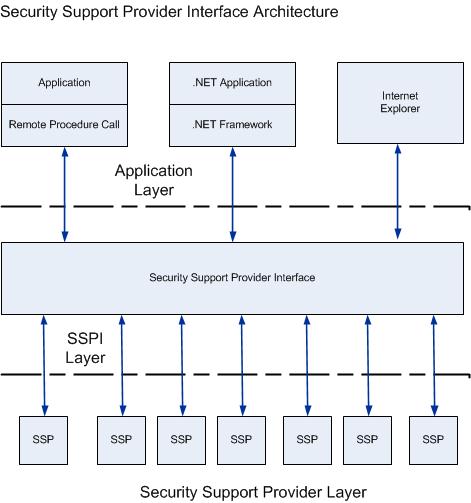Alongside its operating systems, Microsoft offers the Security Support Provider Interface (SSPI) which is the foundation for Windows authentication. The SSPI provides a universal, industry-standard interface for secure distributed applications. SSPI is the implementation of the Generic Security Service API (GSSAPI) in Windows Server operating systems. For more information about GSSAPI, see RFC 2743 and RFC 2744 in the IETF RFC Database.
SSPI is a software interface. Distributed programming libraries such as RPC can use it for authenticated communications. Software modules called SSPs provide the actual authentication capabilities. The default Security Support Providers (SSPs) that invoke specific authentication protocols in Windows are incorporated into the SSPI as DLLs. An SSP provides one or more security packages
Security Support Provider Interface Architecture
The SSPI in Windows provides a mechanism that carries authentication tokens over the existing communication channel between the client computer and the server. When two computers or devices need to be authenticated so that they can communicate securely, the requests for authentication are routed to the SSPI, which completes the authentication process, irrespective of the network protocol currently in use. The SSPI returns transparent binary large objects. These are passed between the applications, at which point they can be passed to the SSPI layer. The SSPI enables an application to use various security models available on a computer or network without changing the interface to the security system.

Security Support Provider
The following sections show the default SSPs that interact with the SSPI. The SSPs are used in different ways in Windows operating systems to enable secure communication in an unsecure network environment. The protocols used by these providers enable authentication of users, computers, and services; the authentication process, in turn, enables authorized users and services to access resources in a secure manner.
- Kerberos Security Support Provider
- NTLM Security Support Provider
- Digest Security Support Provider
- Schannel Security Support Provider
- Negotiate Security Support Provider
- Credential Security Support Provider
- Negotiate Extensions Security Support Provider
- PKU2U Security Support Provider
Using SSPI ensures that no matter which SSP you select, your application accesses the authentication features in a uniform manner. This capability provides your application greater independence from the implementation of the network than was available in the past.
Distributed applications communicate through the RPC interface. The RPC software in turn, accesses the authentication features of an SSP through the SSPI.



